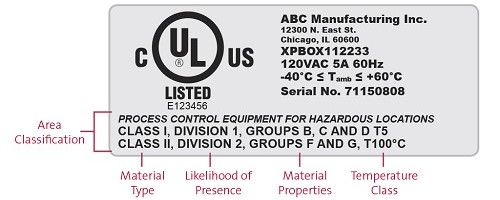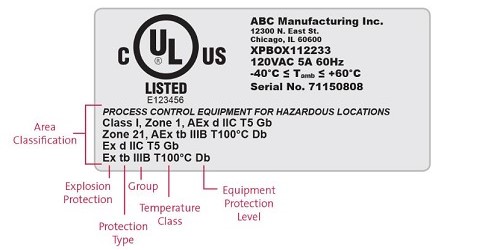What’s the difference between ‘explosion-proof’ and ‘intrinsically safe’ equipment?

What do intrinsically safe and explosion-proof mean?
Intrinsically safe equipment limits thermal and electrical energy to prevent the possibility of ignition. For a hazardous substance, intrinsically safe equipment limits heat generation and buildup to avoid reaching the ignition temperature. For electrical energy, it means preventing the possibility of sparks by keeping voltage and current low.
Explosion-proof equipment can contain an explosion within itself. Creating heavy, thick equipment that can withstand a blast allows for higher wattage.
Whether equipment is intrinsically safe or explosion-proof, it’s designed to prevent a malfunction in electrical process equipment.
Note: We included a more detailed explanation of explosion-proof and intrinsic safety equipment below.
Electrical equipment must sometimes be installed in hazardous locations — areas containing flammable gases, combustible vapours, dust or fibres.
How are hazardous locations classified?
Underwriter's Laboratories (UL), a global safety certification company explains the following. "Hazardous locations are classified by the likelihood of an ignitable concentration of combustible material being present. There are two systems in place, including the traditional North American Division system and the alternative Zone system."
The North American Division System

The North American division system is based on Article 500 of the National Electrical Code® (NEC), which defines a hazardous location by its:
- Class represents the general nature of the hazardous material in the area.
- Divison represents the degree to which the hazard is present in the area.
- Group represents the type of hazardous material in the area.
When determining its classification, individual considerations should be made for each room, section, or area.
Hazardous location class
- Class I: Flammable gases, flammable liquid-produced vapours and combustible liquid-produced vapours.
- Class II: Combustible dust
- Class III: Ignitable fibres or flyings
Hazardous location division
- Division 1: Gases or vapours can be present at any time in sufficient concentrations for an explosion hazard under normal operating conditions.
- Division 2 Gases or vapours are generally not present. They are present only in the event of a leak in some kind of containment vessel or piping, again in potentially hazardous concentrations.
Hazardous location groups for Class I, Division 1 and 2
- Group A Atmospheres containing acetylene.
- Group B Atmospheres containing a flammable gas like hydrogen or fuel/gases containing more than 30% hydrogen by volume, or gases of equivalent hazards to hydrogen.
- Group C Atmospheres containing ethyl-ether vapours, ethylene, or cyclopropane.
- Group D Atmospheres containing gasoline, hexane, naptha, benzene, butane, propane, alcohol, acetone, benzol, lacquer solvent vapours, or natural gas (methane).
Hazardous location groups for Class II, Division 1 and 2
- Group E Atmospheres containing combustible metal dusts including aluminium, titanium, zinc and other metal dusts.
- Group F Atmospheres containing carbonaceous dusts.
- Group G Atmospheres containing combustible dust not included in groups E and F.
The European Zone System

The European zone system is based on articles 505 and 506 of the NEC. This system follows the international method of area classification developed by the International Electrotechnical Commission (IEC). The zone system defines a hazardous location by its:
- Zone represents the general nature of hazardous materials and their probability of being present in an ignitable concentration.
- Group represents the type of hazard and the location of the surrounding atmosphere.
Hazardous location zones | Gases and Vapours
- Zone 0: Flammable gases or vapours present continuously or for long periods.
- Zone 1: Flammable gases or vapours likely to occur under normal conditions.
- Zone 2: Flammable gases or vapours not likely to occur under normal conditions or for a short period.
Hazardous location zones | Dust
- Zone 20: Dusts, fibres or flyings are present continuously or for long periods.
- Zone 21: Dusts, fibres or flyings likely to be present under normal conditions.
- Zone 22: Dusts, fibres or flyings not likely to be present under normal conditions or for a short period.
- Group I: Reserved for mines
- Group II: Explosive gases (zones 0-2)
- Group IIA: Atmospheres containing propane, acetone, benzene and gases of equivalent hazard.
- Group IIB: Atmospheres containing ethylene, propylene oxide, cyclopropane and gases of equivalent hazard.
- Group IIC: Atmospheres containing acetylene, hydrogen, carbon disulphide and gases of equivalent hazard.
- Group III: Explosive dust (zones 20-22)
- Group IIIA: Atmospheres containing combustible flyings.
- Group IIIB: Atmospheres containing non-conductive dust.
- Group IIIC: Atmospheres containing conductive dust.
An in-depth explanation of explosion-proof equipment:
Explosion-proof is the more commonly used method for detector/sensor assemblies for fixed gas detection systems. It's designed for permanent installations that require higher voltage/power.
An explosion-proof classification for a sensor/transmitter means that the housing has been engineered and constructed to contain a flash or explosion. These housings are usually made of cast aluminum or stainless steel. They have sufficient mass and strength to safely contain an explosion should flammable gases or vapours penetrate the housing and the internal electronics or wiring cause an ignition.
The design must prevent any surface temperatures that could exceed the ignition temperature of a gas or vapour. If the sensing element is a high-temperature device (e.g. Catalytic bead or “pellistor”), it may be protected by a flame arrestor to prevent the propagation of high-temperature gases to the ambient atmosphere.
An in-depth explanation of intrinsically safe equipment:
An intrinsically safe classification and design mean that an electronic circuit and its wiring will not cause any sparking or arcing. It cannot store sufficient energy to ignite a flammable gas or vapour and cannot produce a surface temperature high enough to cause ignition.
The intrinsically safe method can also be used for permanent installations where the detector/sensors are relatively low-power devices. Almost all portable instruments are certified intrinsically safe.
Permanent installations may include intrinsically safe barriers that are located outside the hazardous location. These barriers limit the amount of energy available to the device located in the hazardous area.
Still have questions?
Our team at Levitt-Safety can help you understand whether your product is intrinsically safe or explosion-proof.
Get in touch with us today and we'll help guide you through the decision.